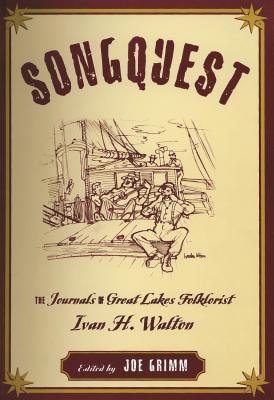


Books in series

Bold Boys in Michigan History
2018

Songquest
The Journals of Great Lakes Folklorist Ivan H. Walton
2005

Uppermost Canada
The Western District and the Detroit Frontier, 1800-1850
2002

Seasons of Grace
A History of the Catholic Archdiocese of Detroit (Great Lakes Books
1990

Toast of the Town
The Life and Times of Sunnie Wilson
1998

Survival and Regeneration
Detroit’s American Indian Community
2017

Queen of the Lakes
1994

John Jacob Astor
Business and Finance in the Early Republic
1991

Steamboats and Sailors of the Great Lakes
1991

Detroit on Stage
The Players Club, 1910-2005
2007

"Expanding the Frontiers of Civil Rights"
Michigan, 1948-1968
2000

To the Copper Country
Mihaela's Journey
2017

Designing Detroit
Wirt Rowland and the Rise of Modern American Architecture
2017

Adversity and Justice
A History of the United States Bankruptcy Court for the Eastern District of Michigan
2016

A Beaver Tale
The Castors of Conners Creek
2016

Justus S. Stearns
Michigan Pine King and Kentucky Coal Baron, 1845-1933
2015

Asian Americans in Michigan
Voices from the Midwest
2015

Mapping Detroit
Land, Community, and Shaping a City
2015

"Old Slow Town"
Detroit during the Civil War
2013

Among the Enemy
A Michigan Soldier's Civil War Journal
2013

The Amphibians and Reptiles of Michigan
A Quaternary and Recent Faunal Adventure
2012

Geology and Landscape of Michigan’s Pictured Rocks National Lakeshore and Vicinity
2012

The United States District Court for the Eastern District of Michigan
People, Law, and Politics
2012

Lake Superior Profiles
People on the Big Lake
2012

Monopoly on Wheels
Henry Ford and the Selden Automobile Patent
2011

The Color of Law
Ernie Goodman, Detroit, and the Struggle for Labor and Civil Rights
2010

Hollowed Ground
Copper Mining and Community Building on Lake Superior, 1840s-1990s
2010

Storied Independent Automakers
Nash, Hudson, and American Motors
2009

A Newscast for the Masses
The History of Detroit Television News
2009

Maxwell Motor and the Making of the Chrysler Corporation
2009

Art in Detroit Public Places
Third Edition
2008

Who's Jim Hines?
2008

A Picturesque Situation
Mackinac Before Photography, 1615-1860
2008

Summer Dreams
The Story of Bob-Lo Island
2008

Tracy W. McGregor
Humanitarian, Philanthropist, and Detroit Civic Leader
2008

When You Come Home
A Wartime Courtship in Letters 1941-45
2007

Life with Mae
A Detroit Family Memoir
2007

Henry Ford
An Interpretation
2007

Learning to Cook in 1898
A Chicago Culinary Memoir
2007

A Pocketful of Passage
2007

A Badger Boy in Blue
The Civil War Letters of Chauncey H. Cooke
2007

In the Shadow of Detroit
Gordon M. Mcgregor, Ford of Canada, and Motoropolis
2006

"I Hope to Do My Country Service"
The Civil War Letters of John Bennitt, M.D., Surgeon, 19th Michigan Infantry
2004

Talking Shops
Detroit Commercial Folk Art
2004

Eight Steamboats
Sailing Through the Sixties
2004

Roy D. Chapin
The Man Behind the Hudson Motor Car Company
2003

Henry's Lieutenants
1993

The Last Good Water
Prose and Poetry, 1988-2003
2003

Beyond the Windswept Dunes
The Story of Maritime Muskegon
2003

The French Canadians of Michigan
Their Contribution to the Development of the Saginaw Valley and the Keweenaw Peninsula, 1840-1914
2003

Michigan's Early Military Forces
A Roster and History of Troops Activated Prior to the American Civil War
2003

For the Good of the Children
A History of the Boys and Girls Republic
2003

Independent Man
The Life of Senator James Couzens
1958

Bridging the River of Hatred
The Pioneering Efforts of Detroit Police Commissioner George Edwards
1998

The Iron Hunter
1919

Windjammers
Songs of the Great Lakes Sailors
2002

The Reuther Brothers
Walter, Roy, and Victor
2001

History of the Finns in Michigan
2001

Diary of Bishop Frederick Baraga First Bishop of Marquette, Michigan
1990

This Is Detroit, 1701-2001
An Illustrated History
2001

Schooner Passage
Sailing Ships and the Lake Michigan Frontier
2000

Looking Beyond Race
The Life of Otis Milton Smith
2000

The Sandstone Architecture of the Lake Superior Region
2000

Tin Stackers
The History of the Pittsburgh Steamship Company
1999

Huron
The Seasons of a Great Lake (Great Lakes Books
1999

A Sailor's Logbook
A Season Aboard Great Lakes Freighters
1999

Wonderful Power
The Story of Ancient Copper Working in the Lake Superior Basin
1999

The Long Winter Ends
1998

Beyond the Model T
The Other Ventures of Henry Ford
1990

In the Wilderness with the Red Indians
German Missionary to the Michigan Indians, 1847-1853
1888

Elmwood Endures
History of a Detroit Cemetery
1996

Master of Precision
Henry M. Leland
1996

The Northern Lights
Lighthouses of the Upper Great Lakes
1994

Ojibwa Narratives of Charles and Charlotte Kawbawgam and Jacques Lepique, 1893-1895
1994

Iron Fleet
The Great Lakes in World War Ii
1994

Cobb Would Have Caught It
The Golden Age of Baseball in Detroit
1991

The Making of a Mining District
Keweenaw Native Copper 1500-1870
1992

Copper Country Journal
The Diary of Schoolmaster Henry Hobart, 1863-1864
1991

Life on the Great Lakes
A Wheelsman's Story
1991

The Legacy of Albert Kahn
1987

Danny and the Boys
Being Some Legends of Hungry Hollow
1987

Freshwater Fury
Yarns and Reminiscences of the Greatest Storm in Inland Navigation
1986

Call It North Country
The Story of Upper Michigan
1986

Michigan Place Names
The History of the Founding and the Naming of More than Five Thousand Past and Present Michigan Communities
1986

Young Henry Ford
A Picture History of the First Forty Years
1963
Authors

Dr. J. Alan Holman was an American paleontologist, herpetologist, and Curator Emeritus of Vertebrate Paleontology at the Michigan State University Museum and Emeritus Professor of Geology and Zoology at Michigan State University. Holman authored twelve books, including two monographs (Pleistocene Amphibians; Reptiles in North America; Pleistocene Amphibians; Reptiles in Britain and Europe) and field guides, such as: Michigan Snakes, Michigan Turtles, Lizards, Michigan Frogs, Toads and Salamanders. The book, The Michigan Roadside Naturalist, was co-authored with, Dr. Margaret B. "Peg" Holman, his wife. His accomplishment include, Honorary Lifetime membership in the Society of Vertebrate Paleontology. https://en.wikipedia.org/wiki/J._Alan...

Librarian Note: There is more than one author in the GoodReads database with this name. See this thread for more information. Various
Grimm, a lifelong Detroit area resident, is a journalism professor at Michigan State University. With his students or by himself, he has published more than 20 books. (source: Amazon)

A 2017 Kresge Artist Fellow in Literary Arts and a former attorney, Jean Alicia Elster (BA, University of Michigan; JD, University of Detroit School of Law) is most recently the author of the young adult novel How It Happens (Wayne State University Press, September 2021). How It Happens was honored as a 2021 Foreword INDIES Silver Winner for Young Adult Fiction and as a 2022 Midwest Book Award Silver Winner in Young Adult Fiction. It was also awarded the 2022 Bronze Medal in Young Adult Fiction by the Independent Publisher Book Awards. It was selected as a 2023 Black History Month Community Read by the Sterling Heights (Michigan) Public Library. Elster is the author of the novel The Colored Car—for ages 8 and older—published by Wayne State University Press and released in September 2013. The Colored Car was selected as a 2014 Michigan Notable Book by the Library of Michigan. It was awarded the 2014 Midwest Book Award in Children’s Fiction and was chosen as an Honor Book for the 2014 Paterson Prize for Books for Young People. Elster is also the author of the novel Who’s Jim Hines?—for ages 8 and older—published by Wayne State University Press and released in August 2008. Among other honors, Who’s Jim Hines? was selected as one of the Library of Michigan’s 2009 Michigan Notable Books. In addition, Elster is the author of the children’s book series “Joe Joe in the City,” published by Judson Press. The first volume in that series, Just Call Me Joe Joe, was released in October 2001. The remaining volumes are: I Have A Dream, Too! (May, 2002), I’ll Fly My Own Plane (September, 2002), and I’ll Do the Right Thing (January, 2003). She was awarded the 2002 Governors’ Emerging Artist Award by ArtServe Michigan in recognition of the series. I’ll Do the Right Thing was awarded the 2004 Atlanta Daily World “Atlanta Choice Award” for children’s books. Elster was honored with a 2017 Kresge Artist Fellowship in Literary Arts, a program of The Kresge Foundation. In addition, Elster’s essays have appeared in national publications including Ms., World Vision, Black Child, and Christian Science Sentinel magazines. Her short story “Alphabet Day” was published in the First Annual Metro Times-Detroit Fiction Issue. She has been awarded three residencies at the internationally acclaimed Ragdale Foundation (Lake Forest, Illinois). She was the featured author for the Black Her Stories podcast, season one, episode five. Elster was selected to be a member of the 2020-2022 Live Coal Gallery/Knight Foundation collaborative. She is frequently invited to speak at schools, libraries, and conferences throughout the state of Michigan and across the United States. Engagements include the following representative events: In 2023, Elster was the keynote speaker when How It Happens was selected as the Black History Month Community Read at the Sterling Heights (Michigan) Public Library. She was a panelist for “Black Trauma, Black Joy – Telling Hard Stories to Young Readers” at the Association of Writers and Writing Professionals (AWP) Conference, Seattle, Washington. She was a presenter for “Oral Histories and the Creation of Historical Fiction for Young Readers” at the Michigan Reading Association 67th Annual Conference, Grand Rapids, Michigan. Elster In 2022, Elster was a guest presenter for two programs at the Detroit Historical Museum. She was the keynote speaker for the Warren Consolidated Schools Writing Celebration (Michigan). She was also a guest speaker for the Kalamazoo (Michigan) Public Library’s Youth Author Series. In 2021, Elster was a guest author at the Get Inked Teen Writing Conference at St. Mary’s College, Notre Dame, Indiana. She was a guest presenter for the Room Project’s Women in Prose from Wayne State University Press event and was a panelist for the Wayne State University Press Publishing Symposium. She was a featured author for the Jackson County (Michigan) Intermediate School District’s Jackson Reads! literacy program.

American politician, newspaper reporter and publisher, and explorer who served as 27th Governor of Michigan from 1911 to 1913. Chase published newspapers in Florence, Wisconsin and Sault Ste. Marie, Michigan. In 1889 he was appointed postmaster and in 1898 Commissioner of Railroads. In 1900, he was unsuccessful to win the Republican nomination for Governor of Michigan, losing to Aaron T. Bliss, who won the general election. In 1908, he served as a delegate to the Republican National Convention from Michigan to nominate William Howard Taft for U.S. President. In 1910, Osborn was elected the 27th Governor of Michigan and served from 1911 to 1913. His tenure as governor was focused on reforms as the state deficit was eliminated; a workmen's compensation bill was sanctioned; and a presidential primary law was authorized. After his term as governor, Osborn traveled the world and came back for another attempt to become governor again and unseat his successor, Democrat Woodbridge Nathan Ferris, but was unsuccessful.

